Before doing any migration, it is important to understand the concept of functional levels
in Windows Server 2003 and how these levels affect the functionality of
Windows Server 2003. To understand functional levels, we will briefly
review the concept of naming contexts (NCs), which will make the
functionality issue easier to understand.
Windows 2000 had functional
levels too, but they weren't referred to as such. These levels in
Windows 2000 were called mixed mode and native mode. In Windows 2000,
going to native mode basically meant that you could no longer add
Windows NT Backup Domain Controllers (BDCs) to the domain. You can have
Windows NT servers and Win9x, Windows NT Workstation, Windows 2000 Pro,
and Windows XP clients; you just can't add any Windows NT BDCs.
Similarly,
Windows 2003 has native- and mixed-mode domains, but the words “native”
and “mixed” are not used. “Native” is called “Windows 2003” and “mixed”
shows up in the User interface (UI) as Windows 2000 Native or Windows
2000 Mixed. Also, the process of going to native mode in Windows Server
2003 is referred to as raising the functional level.
A Windows 2003 level (native) domain allows only Windows Server 2003
DCs and no Windows 2000 or Windows NT DCs, but does allow downlevel
clients and member servers.
A Review of Naming Context (NC)
Windows 2000 and
Windows 2003 have three NCs, or partitions, of the AD: the configuration
NC, the schema NC, and the domain NC. There is only one configuration
and schema NC, but there will be a separate NC for each domain. If we
have the company.com domain and it has a child domain, NA.company.com,
there would be a total of four naming contexts: one each of
configuration and schema NCs, the company.com NC, and the NA.company.com
NC.
We call these naming contexts partitions
of the AD because certain functions take place only in certain
partitions. For example, an operation that modifies a user object
operates within the domain NC because the user is in the domain NC and
affects only DCs in that domain. This also affects security because a
domain Admin has rights to make modifications in the domain NC that he
or she is a member of.
Modifying the schema
obviously takes place in the schema NC, while replication topology is
stored in the configuration NC. That's why you have to be an Enterprise
Admin to make changes to replication features such as sites or site
links. These types of changes require access to the configuration NC and
affects DCs across domain boundaries.
This is important to the discussion of functional levels in the next section.
Domain Functional Level
Unlike Windows 2000, you
cannot switch a Windows 2003 domain to native mode if there are
downlevel (Windows NT or Windows 2000) DCs in the domain. Figure 1
shows the result of an attempt to raise the functional level of a
Windows Server 2003 domain to Windows 2003 level (native). Windows
detects that one or more Windows 2000 DCs are in the domain and
prohibits raising the functional level. In addition, a Save As button is
available that creates a comma separated value (CSV) file listing of
all DCs that are still at Windows 2000. A typical output looks like this
one from the QAmericas domain at HP. One DC was upgraded to Windows
2003 and all other DCs were still at Windows 2000.
"To update the forest functional level, the domain controllers in the forest must be running the appropriate version of windows, and no domains in the forest can have a domain functional level of Windows 2000 mixed or Windows Server 2003."
Forest root domain name
Qtest.cpqcorp.net
Current forest functional level
Windows 2000
The following domains include domain controllers that are running earlier versions of windows:
Domain Name Domain Controller Version of Windows
Qamericas.Qtest.cpqcorp.net QAmericas-DC39.Qamericas.Qtest.cpqcorp.net Windows 2000 Server 5.0 (2195)
Qamericas.Qtest.cpqcorp.net qamericas-DcJc.Qamericas.Qtest.cpqcorp.net Windows 2000 Server 5.0 (2195)
Qamericas.Qtest.cpqcorp.net qamericas-dc10.Qamericas.Qtest.cpqcorp.net Windows 2000 Server 5.0 (2195)
Qamericas.Qtest.cpqcorp.net QAMERICAS-DC2.Qamericas.Qtest.cpqcorp.net Windows 2000 Server 5.0 (2195)
Qamericas.Qtest.cpqcorp.net qamericas-dc3.Qamericas.Qtest.cpqcorp.net Windows 2000 Server 5.0 (2195)
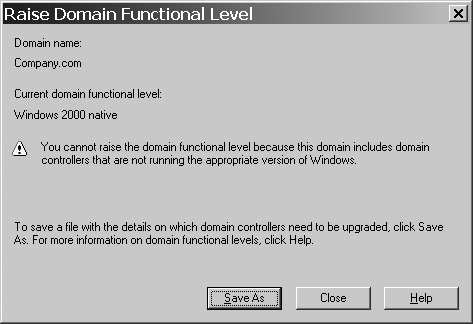
The page width
restriction causes the “version of Windows” column to be wrapped to the
next line, but you can see how this report quickly tells you which
machines must be upgraded before you can raise the functional level.
By default, a Windows 2003
domain, whether it is created in a new installation or migrated from
Windows 2000, is configured in Windows 2000 mixed or native
mode—depending on the mode of the Windows 2000 domain at the time of
migration. Like Windows 2000, you must manually trigger the domain
functionality, which you do either from the Active Directory Users and
Computers or the Domains and Trusts snap-ins, as shown in Figure 2.
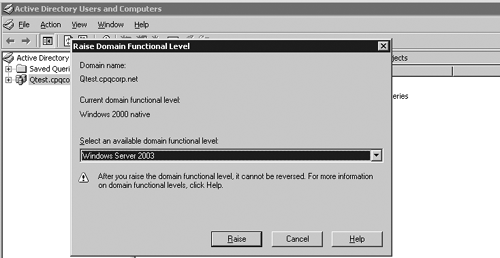
Forest Functional Level
Windows Server 2003 takes the concept of native mode one step further and introduces forest level native mode. Thus, you can raise the domain level and
raise the forest level to Windows 2003 level. To raise the forest
level, all DCs in all domains in the forest must be at Windows Server
2003 level or you will get a similar error to that seen when raising the
domain functional level when Windows 2000 DCs are in the domain.
The forest functional level is a
bit tricky to find. Open the Domains and Trusts snap-in, and right-click
on the Active Directory Domains and Trusts icon, as shown in Figure 3. From this dialog box, you can raise the functional level to Windows Server 2003.
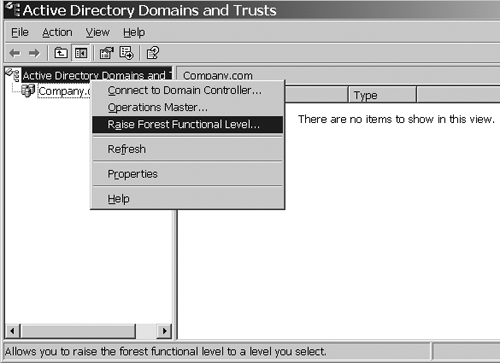
Interim Mode
As if all of this weren't confusing enough, there is interim
mode. Interim mode is a temporary mode used when doing an in-place
upgrade from Windows NT to Windows Server 2003. This mode allows Windows
NT to participate in a Windows 2003 native-mode domain for the purpose
of migration. That is, after you upgrade the Windows NT Primary Domain
Controller (PDC), you have a Windows Server 2003 native-mode domain with
all your BDCs in it. If interim mode were not provided, the BDCs could
not function in the domain. Note that interim mode does not allow
Windows 2000 DCs. When you perform an in-place upgrade, you are allowed
to set the domain to interim mode during the setup. At the conclusion of
the upgrade, you can raise the functionality to Windows Server 2003.
There is no way to manually specify interim mode via a snap-in.
Functional Level Interoperability
Now comes the hard
part—figuring out possible allowable DC configurations in a mixed-mode
forest—meaning you can have various combinations of Windows 2000,
Windows Server 2003, and Windows NT in domains within a mixed-mode
forest. Let's start by reviewing a Windows 2000 forest. This forest,
illustrated in Figure 4,
can have a Windows 2000 native-mode domain in the same forest with
Windows 2000 mixed-mode domains. The mixed-mode domains can have Windows
2000 and Windows NT DCs.
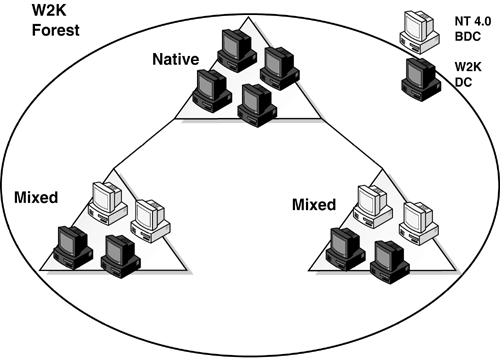
Similarly, a Windows 2003
forest whose functional level has not been raised can have domains of
various configurations, as shown in Figure 5.
For instance, you can have a Windows Server 2003 native-mode domain
with Windows Server 2003 DCs in all domains, a Windows 2000 native-mode
domain with Windows 2000 and Windows 2003 DCs (or just Windows 2000
DCs), and a Windows 2000 mixed-mode domain with Windows 2000, Windows
2003, and Windows NT DCs—all in the same forest.
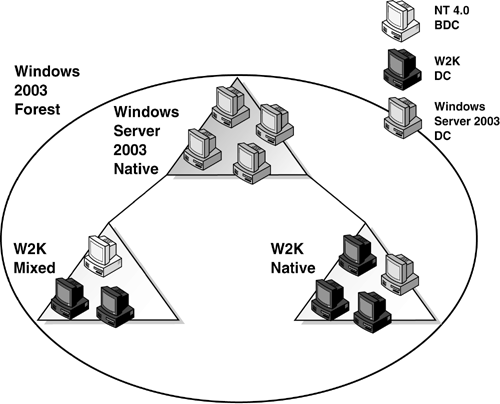
Figure 6
shows that all DCs in all domains in the forest have been upgraded to
Windows Server 2003, the domain functional level has been raised to
Windows 2003, and the forest level has been raised to Windows 2003.
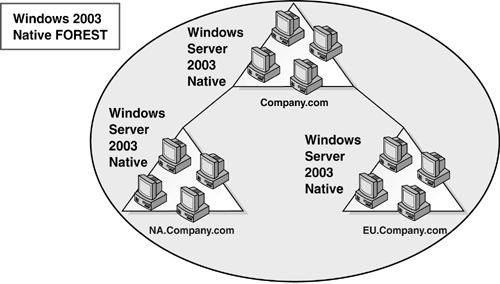
note
Functional levels
refer only to the status of DCs, not workstations or member servers.
Downlevel member servers and workstations can still exist in a
native-mode Windows Server 2003 domain and forest just like they could
exist in a Windows 2000 native-mode domain.
Windows Server 2003 Functionality
The functional level of the
Windows Server 2003 domain and forest determines which of the Windows
Server 2003 features are available and operating. Going back to our
discussion earlier in this section on NCs, Windows Server 2003 features
that operate within the domain NC require a Windows 2003 domain
functional level. Features that operate within the configuration and
schema NCs require a Windows 2003 forest functional level. Table 1 shows the Windows Server 2003 features available for mixed, interim, and native domain functional levels. Table 2 shows features available for mixed and native forest functional levels.
Table 1. Feature List for Windows Server 2003 Domain Functional Levels
| Functional Level | Features Enabled | DCs Supported |
|---|
| Windows 2000 Mixed | Basic Windows 2000 | Windows NT 4.0, Windows 2000, Windows Server 2003 |
| Windows 2000 Native | Group
nesting, universal groups, greater scalability (no SAM limits),
SIDHistory Cleanup, conversion between distribution and security groups | Windows 2000, Windows Server 2003 |
| Windows Server 2003 Interim Forest Mode | N/A | Windows NT 4.0 and Windows Server 2003 |
| Windows Server 2003 Native | All features above, plus cross forest trust, logon time stamp, user password support on InetOrgPerson object | Windows Server 2003 |
Table 2. Feature List for Windows Server 2003 Forest Functional Level
| Functional Level | Features Enabled | DCs Supported |
|---|
| Windows 2000 | Basic Windows 2000 | Windows NT 4.0, Windows 2000, Windows Server 2003 |
| Windows Server 2003 Interim | LVR, improved Knowledge Consistency Checker (KCC) performance, additional attributes added to the PAS on GCs | Windows NT 4.0 Windows 2003 |
| Windows Server 2003 | All features of interim mode plus cross forest trust, InetOrgPerson object | Windows 2003 |
Note that because DC rename
is a function that modifies objects in the domain NC, only domain
functional level is required. However, to get full benefit of
improvements to the KCC for replication performance and Domain Rename,
the forest must be raised to Windows 2003 level because the
configuration details of those operations are on all DCs and thus in the
configuration NC. To find out if a feature requires raising the domain
or the forest functional level, determine whether its scope is in the
domain, configuration, or schema NC.
tip
Remember, you can have the domain features available on a domain-by-domain basis.